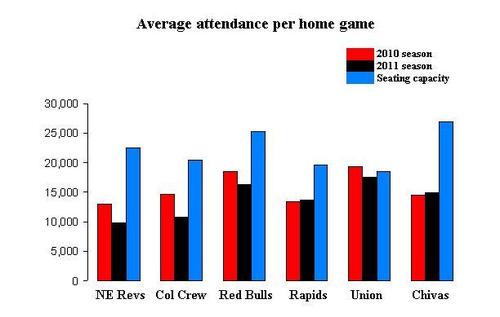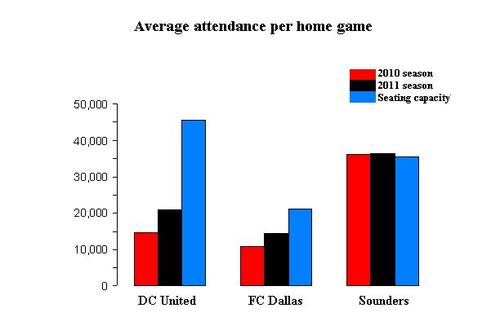The MLS family welcomed two new additions to the 2011 season, the Portland Timbers and the Vancouver Whitecaps, increasing the number to 18 clubs. One of the original members, Kansas City Wizards rebranded themselves Sporting Kansas City, a European touch as the club included other sports like lacrosse and rugby. They also await moving to the new Livestrong Stadium, their third home which opens June 9.
In 2012, the Montreal Impact will join the MLS and in a few years, New York could see a derby between the Red Bulls and a reincarnated Cosmos. But the expansion might not just stop there as Don Garber indicated that the MLS could very well end up having more than 20 teams in the not so near future with interest being generated in several markets.
This season has seen the return of many prominent European based US players notably Jay De Merit and Benny Feilhaber. Charlie Davies, the 2009 USMNT standout has provided the season’s biggest buzz returning to the sport with a vengeance after potentially career ending injuries kept him out for a year. He moved from Sochaux to DC United in a loan move.
The MLS has also established itself as a league that big European teams love to travel to in their off season and this year is no exception as Man Utd, Barcelona, and Real Madrid come knocking.
These developments augur well for future growth and profitability. Player salaries and portability have improved and while the MLS still does not attract top notch foreign talent in their prime it has a smattering of big names that generate an audience. However, the bottomline is and will always be, the number of supporters who show up to see matches. The MLS shows a decidedly less rosy picture on that front.

The above graph shows a subset of the 10 original MLS franchises with declining or sub par attendances after a quarter of this season gone by. Even last years inductee, the Philadelphia Union dipped in attendance. Chivas USA, the club linked with the storied Mexican club and boasting a huge Hispanic base continue to operate at disappointing 50% level.
The Revs decline has much to do with a club stuck in reverse. The arrival of Benny Feilhaber bolstering Shalrie Joseph’s midfield creativity might lead to an uptick but the Revs have not attracted the marquee names like the Red Bulls. For the first time under Steve Nicol, the franchise failed to make the playoffs last season after eight years. There they cemented a frustrating Buffalo Bills type of frailty, losing all four MLS finals.
Even big ticket boosters like Thierry Henry and Rafa Marquez are not enough it seems as New York has failed to fill seats. Exciting national prospects like Juan Aguadelo and Tim Ream are fodder for fevered online forums but it has not translated to an increased presence. Juan Pablo Angel, the long time Red Bulls/ Metrostars warrior move to LA might be a factor. The former Aston Villa striker was known for his skill and gutsy performances. It’s the same story for the Rapids. The bloom from their first MLS Cup triumph has provided no special incentive. An Eagles vs Giants type of rivalry clearly evident in the Union’s April 9th encounter with the Red Bulls was witnessed by a record 19,027 attendees. But there are fewer takers for the other matches.

The second graph shows two clubs that have shown an improvement with DC United benefiting from the Charlie Davies factor. FC Dallas’s brand of attacking soccer with a Latin flair finds an eager audience with David Ferreira and Marvin Chavez leading the way. Ruben Luna, a home grown player is being followed keenly and Fabian Castillo, a Colombian import adds depth to the striker corps.
As has been the case the previous two seasons, it is the Sounders who consistently sellout Qwest, bringing up the MLS numbers. Seattle’s fan base, a network of highly educated young technocrats are a passionate and knowledgeable group. They now have North West rivals in Portland and Vancouver, two other cities with comparable demographics which can only burgeon attendance.
This post’s purpose is to open up debate. The overarching theme is of a league on the upswing but narrower indicators like average attendances also show uneven trends and decline in some instances. The focus should not just be on a lateral spread but also to find ways to deepen the existing audience.
2 comments on “Is the MLS spreading itself too thin?”





Speaking as a Revolution season-ticket holder, who’s been to many a lonely night at cavernous Gillette Stadium, the location also has a lot to do with it. It’s far from Boston. Couple that with a couple years of lousy, uninspiring play, zero or bad marketing, and a city that expects the best, and it’s not going to be a success. They’re doing more things right this year, but a downtown stadium will always be the key to making a big leap.
Hi Rob: Somehow that 30 + miles to Gillette has a lot to do with it. Even the Red Bulls nominally a New York team is less than 10 miles away in their Harrison, NJ home. The Revs should be jumping on the soccer specific stadium bandwagon. Kansas and Houston are moving to new stadiums and DC United could also get their wish for a new home away from cavernous RFK if their financial wranglings are sorted out.